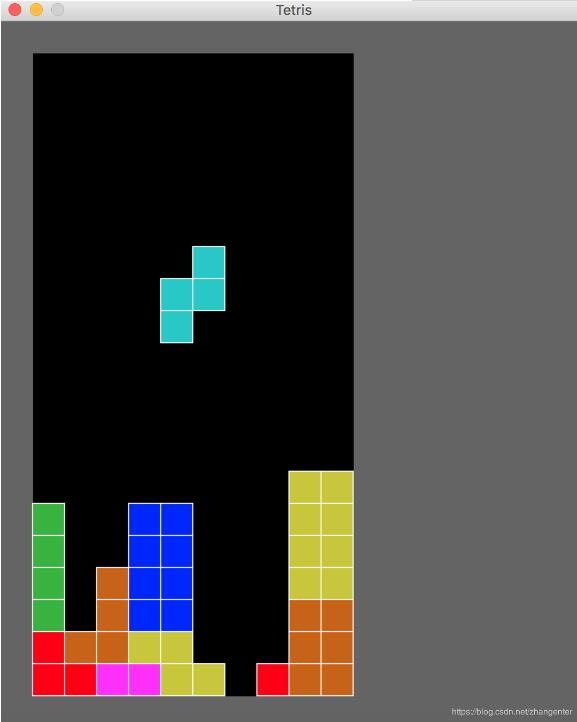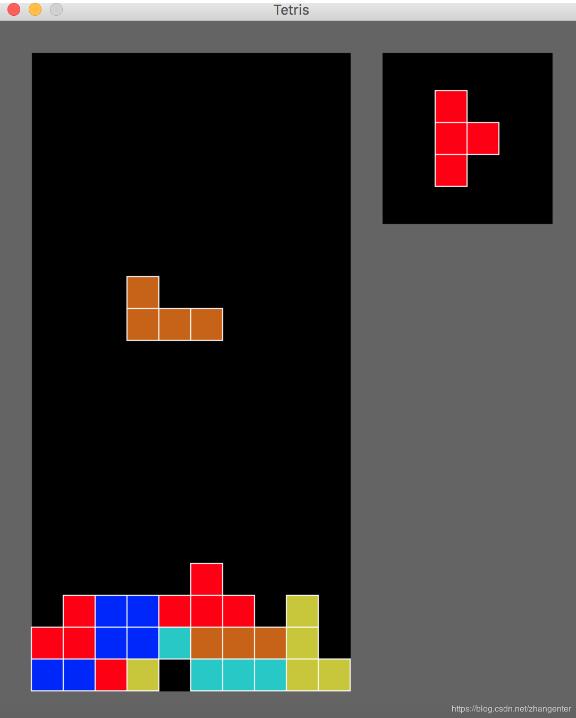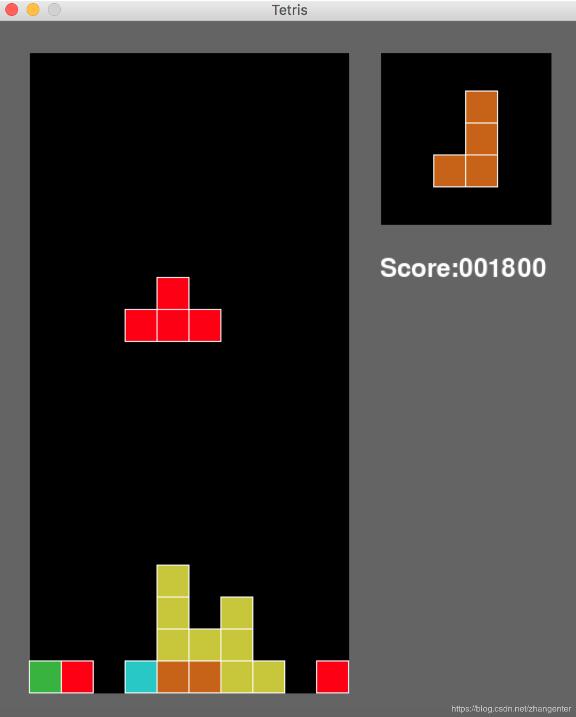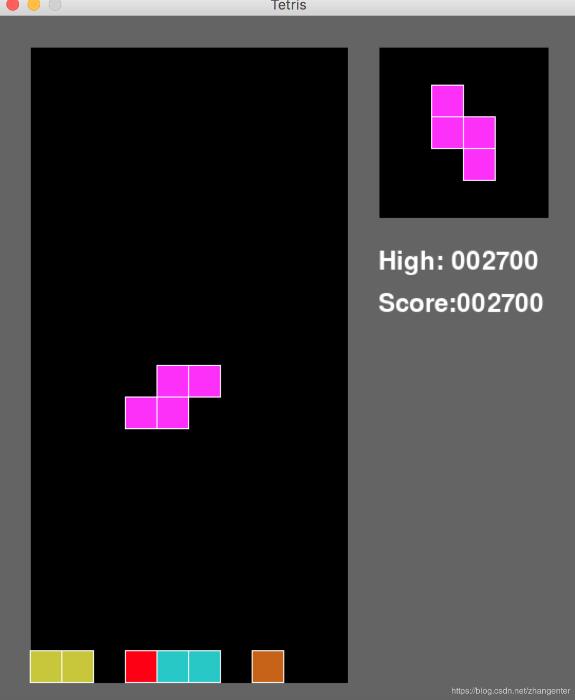pygame实现俄罗斯方块游戏(基础篇3)
上一章请点击查看:pygame实现俄罗斯方块游戏(基础篇2)
现在继续
一、给每个方块设置不同的颜色
根据代码这里可以判断正在下落的方块在那些Block子类里加一个属性最合适,而已经落下的方块颜色管理最合适的地方应该是修改在Panel类里的rect_arr
Block子类里的修改比较简单,以TBlock类为例,在__init__函数加一行
self.color=(255,0,0)
在Panel的paint函数里将代码
# 绘制正在落下的方块 if self.move_block: for rect in self.moving_block.get_rect_arr(): x,y=rect pygame.draw.line(self._bg,[0,0,255],[self._x+x*bz+bz/2,self._y+y*bz],[self._x+x*bz+bz/2,self._y+(y+1)*bz],bz) pygame.draw.rect(self._bg,[255,255,255],[self._x+x*bz,self._y+y*bz,bz+1,bz+1],1)
中的
pygame.draw.line(self._bg,[0,0,255],[self._x+x*bz+bz/2,self._y+y*bz],[self._x+x*bz+bz/2,self._y+(y+1)*bz],bz)
改成
pygame.draw.line(self._bg,self.moving_block.color,[self._x+x*bz+bz/2,self._y+y*bz],[self._x+x*bz+bz/2,self._y+(y+1)*bz],bz)
已经下落的方块修改会麻烦一点,原来存在rect_arr里的是x,y,现在要增加一个颜色,直接改也是可以的,不过考虑到以后的扩展性,果断定义一个RectInfo类
class RectInfo(object): def __init__(self, x, y, color): self.x = x self.y = y self.color = color
将存入rect_arr时的代码修改为
def add_block(self,block): for x,y in block.get_rect_arr(): self.rect_arr.append(RectInfo(x,y, block.color))
并将设计rect_arr做下修改即可

贴下目前的完整代码
# -*- coding=utf-8 -*-
import random
import pygame
from pygame.locals import KEYDOWN,K_LEFT,K_RIGHT,K_UP,K_DOWN,K_SPACE
class RectInfo(object):
def __init__(self, x, y, color):
self.x = x
self.y = y
self.color = color
class Panel(object): # 用于绘制整个游戏窗口的版面
rect_arr=[] # 已经落底下的方块
moving_block=None # 正在落下的方块
def __init__(self,bg, block_size, position):
self._bg=bg;
self._x,self._y,self._width,self._height=position
self._block_size=block_size
self._bgcolor=[0,0,0]
def add_block(self,block):
for x,y in block.get_rect_arr():
self.rect_arr.append(RectInfo(x,y, block.color))
def create_move_block(self):
block = create_block()
block.move(5-2,-2) # 方块挪到中间
self.moving_block=block
def check_overlap(self, diffx, diffy, check_arr=None):
if check_arr is None: check_arr = self.moving_block.get_rect_arr()
for x,y in check_arr:
for rect_info in self.rect_arr:
if x+diffx==rect_info.x and y+diffy==rect_info.y:
return True
return False
def control_block(self, diffx, diffy):
if self.moving_block.can_move(diffx,diffy) and not self.check_overlap(diffx, diffy):
self.moving_block.move(diffx,diffy)
def change_block(self):
if self.moving_block:
new_arr = self.moving_block.change()
if new_arr and not self.check_overlap(0, 0, check_arr=new_arr): # 变形不能造成方块重叠
self.moving_block.rect_arr=new_arr
def move_block(self):
if self.moving_block is None: create_move_block()
if self.moving_block.can_move(0,1) and not self.check_overlap(0,1):
self.moving_block.move(0,1)
return 1
else:
self.add_block(self.moving_block)
self.check_clear()
for rect_info in self.rect_arr:
if rect_info.y<0: return 9 # 游戏失败
self.create_move_block()
return 2
def check_clear(self):
tmp_arr = [[] for i in range(20)]
# 先将方块按行存入数组
for rect_info in self.rect_arr:
if rect_info.y<0: return
tmp_arr[rect_info.y].append(rect_info)
clear_num=0
clear_lines=set([])
y_clear_diff_arr=[[] for i in range(20)]
# 从下往上计算可以消除的行,并记录消除行后其他行的向下偏移数量
for y in range(19,-1,-1):
if len(tmp_arr[y])==10:
clear_lines.add(y)
clear_num += 1
y_clear_diff_arr[y] = clear_num
if clear_num>0:
new_arr=[]
# 跳过移除行,并将其他行做偏移
for y in range(19,-1,-1):
if y in clear_lines: continue
tmp_row = tmp_arr[y]
y_clear_diff=y_clear_diff_arr[y]
for rect_info in tmp_row:
#new_arr.append([x,y+y_clear_diff])
new_arr.append(RectInfo(rect_info.x, rect_info.y+y_clear_diff, rect_info.color))
self.rect_arr = new_arr
def paint(self):
mid_x=self._x+self._width/2
pygame.draw.line(self._bg,self._bgcolor,[mid_x,self._y],[mid_x,self._y+self._height],self._width) # 用一个粗线段来填充背景
# 绘制已经落底下的方块
bz=self._block_size
for rect_info in self.rect_arr:
x=rect_info.x
y=rect_info.y
pygame.draw.line(self._bg,rect_info.color,[self._x+x*bz+bz/2,self._y+y*bz],[self._x+x*bz+bz/2,self._y+(y+1)*bz],bz)
pygame.draw.rect(self._bg,[255,255,255],[self._x+x*bz,self._y+y*bz,bz+1,bz+1],1)
# 绘制正在落下的方块
if self.move_block:
for rect in self.moving_block.get_rect_arr():
x,y=rect
pygame.draw.line(self._bg,self.moving_block.color,[self._x+x*bz+bz/2,self._y+y*bz],[self._x+x*bz+bz/2,self._y+(y+1)*bz],bz)
pygame.draw.rect(self._bg,[255,255,255],[self._x+x*bz,self._y+y*bz,bz+1,bz+1],1)
class Block(object):
sx=0
sy=0
def __init__(self):
self.rect_arr=[]
def get_rect_arr(self): # 用于获取方块种的四个矩形列表
return self.rect_arr
def move(self,xdiff,ydiff): # 用于移动方块的方法
self.sx+=xdiff
self.sy+=ydiff
self.new_rect_arr=[]
for x,y in self.rect_arr:
self.new_rect_arr.append((x+xdiff,y+ydiff))
self.rect_arr=self.new_rect_arr
def can_move(self,xdiff,ydiff):
for x,y in self.rect_arr:
if y+ydiff>=20: return False
if x+xdiff<0 or x+xdiff>=10: return False
return True
def change(self):
self.shape_id+=1 # 下一形态
if self.shape_id >= self.shape_num:
self.shape_id=0
arr = self.get_shape()
new_arr = []
for x,y in arr:
if x+self.sx<0 or x+self.sx>=10: # 变形不能超出左右边界
self.shape_id -= 1
if self.shape_id < 0: self.shape_id = self.shape_num - 1
return None
new_arr.append([x+self.sx,y+self.sy])
return new_arr
class LongBlock(Block):
shape_id=0
shape_num=2
def __init__(self, n=None): # 两种形态
super(LongBlock, self).__init__()
if n is None: n=random.randint(0,1)
self.shape_id=n
self.rect_arr=self.get_shape()
self.color=(50,180,50)
def get_shape(self):
return [(1,0),(1,1),(1,2),(1,3)] if self.shape_id==0 else [(0,2),(1,2),(2,2),(3,2)]
class SquareBlock(Block): # 一种形态
shape_id=0
shape_num=1
def __init__(self, n=None):
super(SquareBlock, self).__init__()
self.rect_arr=self.get_shape()
self.color=(0,0,255)
def get_shape(self):
return [(1,1),(1,2),(2,1),(2,2)]
class ZBlock(Block): # 两种形态
shape_id=0
shape_num=2
def __init__(self, n=None):
super(ZBlock, self).__init__()
if n is None: n=random.randint(0,1)
self.shape_id=n
self.rect_arr=self.get_shape()
self.color=(30,200,200)
def get_shape(self):
return [(2,0),(2,1),(1,1),(1,2)] if self.shape_id==0 else [(0,1),(1,1),(1,2),(2,2)]
class SBlock(Block): # 两种形态
shape_id=0
shape_num=2
def __init__(self, n=None):
super(SBlock, self).__init__()
if n is None: n=random.randint(0,1)
self.shape_id=n
self.rect_arr=self.get_shape()
self.color=(255,30,255)
def get_shape(self):
return [(1,0),(1,1),(2,1),(2,2)] if self.shape_id==0 else [(0,2),(1,2),(1,1),(2,1)]
class LBlock(Block): # 四种形态
shape_id=0
shape_num=4
def __init__(self, n=None):
super(LBlock, self).__init__()
if n is None: n=random.randint(0,3)
self.shape_id=n
self.rect_arr=self.get_shape()
self.color=(200,200,30)
def get_shape(self):
if self.shape_id==0: return [(1,0),(1,1),(1,2),(2,2)]
elif self.shape_id==1: return [(0,1),(1,1),(2,1),(0,2)]
elif self.shape_id==2: return [(0,0),(1,0),(1,1),(1,2)]
else: return [(0,1),(1,1),(2,1),(2,0)]
class JBlock(Block): # 四种形态
shape_id=0
shape_num=4
def __init__(self, n=None):
super(JBlock, self).__init__()
if n is None: n=random.randint(0,3)
self.shape_id=n
self.rect_arr=self.get_shape()
self.color=(200,100,0)
def get_shape(self):
if self.shape_id==0: return [(1,0),(1,1),(1,2),(0,2)]
elif self.shape_id==1: return [(0,1),(1,1),(2,1),(0,0)]
elif self.shape_id==2: return [(2,0),(1,0),(1,1),(1,2)]
else: return [(0,1),(1,1),(2,1),(2,2)]
class TBlock(Block): # 四种形态
shape_id=0
shape_num=4
def __init__(self, n=None):
super(TBlock, self).__init__()
if n is None: n=random.randint(0,3)
self.shape_id=n
self.rect_arr=self.get_shape()
self.color=(255,0,0)
def get_shape(self):
if self.shape_id==0: return [(0,1),(1,1),(2,1),(1,2)]
elif self.shape_id==1: return [(1,0),(1,1),(1,2),(0,1)]
elif self.shape_id==2: return [(0,1),(1,1),(2,1),(1,0)]
else: return [(1,0),(1,1),(1,2),(2,1)]
def create_block():
n = random.randint(0,19)
if n==0: return SquareBlock(n=0)
elif n==1 or n==2: return LongBlock(n=n-1)
elif n==3 or n==4: return ZBlock(n=n-3)
elif n==5 or n==6: return SBlock(n=n-5)
elif n>=7 and n<=10: return LBlock(n=n-7)
elif n>=11 and n<=14: return JBlock(n=n-11)
else: return TBlock(n=n-15)
def run():
pygame.init()
space=30
main_block_size=30
main_panel_width=main_block_size*10
main_panel_height=main_block_size*20
screencaption = pygame.display.set_caption('Tetris')
screen = pygame.display.set_mode((main_panel_width+160+space*3,main_panel_height+space*2)) #设置窗口长宽
main_panel=Panel(screen,main_block_size,[space,space,main_panel_width,main_panel_height])
pygame.key.set_repeat(200, 30)
main_panel.create_move_block()
diff_ticks = 300 # 移动一次蛇头的事件,单位毫秒
ticks = pygame.time.get_ticks() + diff_ticks
game_state = 1 # 游戏状态1.表示正常 2.表示失败
while True:
for event in pygame.event.get():
if event.type == pygame.QUIT:
pygame.quit()
exit()
if event.type == KEYDOWN:
if event.key == K_LEFT: main_panel.control_block(-1,0)
if event.key == K_RIGHT: main_panel.control_block(1,0)
if event.key == K_UP: main_panel.change_block()
if event.key == K_DOWN: main_panel.control_block(0,1)
if event.key == K_SPACE:
flag = main_panel.move_block()
while flag==1:
flag = main_panel.move_block()
if flag == 9: game_state = 2
screen.fill((100,100,100)) # 将界面设置为灰色
main_panel.paint() # 主面盘绘制
if game_state == 2:
myfont = pygame.font.Font(None,30)
white = 255,255,255
textImage = myfont.render("Game over", True, white)
screen.blit(textImage, (160,190))
pygame.display.update() # 必须调用update才能看到绘图显示
if game_state == 1 and pygame.time.get_ticks() >= ticks:
ticks+=diff_ticks
if main_panel.move_block()==9: game_state = 2 # 游戏结束
run()
二、下一个方块
为便于下一方块的提示窗的绘制,我们定义一个类HintBox,用于管理下一方块和界面的绘制
class HintBox(object): next_block=None def __init__(self, bg, block_size, position): self._bg=bg; self._x,self._y,self._width,self._height=position self._block_size=block_size self._bgcolor=[0,0,0] def take_block(self): block = self.next_block if block is None: # 如果还没有方块,先产生一个 block = create_block() self.next_block = create_block() # 产生下一个方块 return block def paint(self): mid_x=self._x+self._width/2 pygame.draw.line(self._bg,self._bgcolor,[mid_x,self._y],[mid_x,self._y+self._height],self._width) bz=self._block_size # 绘制正在落下的方块 if self.next_block: arr = self.next_block.get_rect_arr() minx,miny=arr[0] maxx,maxy=arr[0] for x,y in arr: if x<minx: minx=x if x>maxx: maxx=x if y<miny: miny=y if y>maxy: maxy=y w=(maxx-minx)*bz h=(maxy-miny)*bz # 计算使方块绘制在提示窗中心位置所需要的偏移像素 cx=self._width/2-w/2-minx*bz-bz/2 cy=self._height/2-h/2-miny*bz-bz/2 for rect in arr: x,y=rect pygame.draw.line(self._bg,self.next_block.color,[self._x+x*bz+cx+bz/2,self._y+cy+y*bz],[self._x+x*bz+cx+bz/2,self._y+cy+(y+1)*bz],bz) pygame.draw.rect(self._bg,[255,255,255],[self._x+x*bz+cx,self._y+y*bz+cy,bz+1,bz+1],1)
在Panel类里面增加一个属性
hint_box=None
将Panel类里面的
def create_move_block(self): block = create_block() block.move(5-2,-2) # 方块挪到中间 self.moving_block=block
产生方块的方式,改为由hint_box产生
def create_move_block(self): block = self.hint_box.take_block() block.move(5-2,-2) # 方块挪到中间 self.moving_block=block
在run函数里增加初始化hint_box和设置main_panel的程序
hint_box=HintBox(screen,main_block_size,[main_panel_width+space+space,space,160,160]) main_panel.hint_box=hint_box
在游戏主循环增加下一方块提示窗的绘制
hint_box.paint() # 绘制下一个方块的提示窗
现在可以正常显示下一方块提示了

三、分数的计算
消除分数的计算方式为
1行 100分
2行 300分
3行 800分
4行 1600分
类似下一方块提示窗的设计,我们可以增加一个ScoreBox类
class ScoreBox(object):
total_score = 0
def __init__(self, bg, block_size, position):
self._bg=bg;
self._x,self._y,self._width,self._height=position
self._block_size=block_size
self._bgcolor=[0,0,0]
def paint(self):
myfont = pygame.font.Font(None,36)
white = 255,255,255
textImage = myfont.render('Score:%06d'%(self.total_score), True, white)
self._bg.blit(textImage, (self._x,self._y))
然后在Panel增加score_box属性
score_box=None
定义一个全局的SCORE_MAP
SCORE_MAP=(100,300,800,1600)
在check_clear函数中,如果有方块消除,则执行
score = SCORE_MAP[clear_num-1] self.score_box.total_score += score
在run主函数初始化score_box
score_box=ScoreBox(screen,main_block_size,[main_panel_width+space+space,160+space*2,160,160]) main_panel.score_box=score_box
并在游戏循环绘制score_box
score_box.paint() # 绘制总分

四、历史最高分
准备在当前目录用一个tetris.db的pickle文件保存
所以首先
import pickle,os
由于最高分可以借用ScoreBox在绘制当前分数时一起绘制,所以直接在ScoreBox增加一个最高分的属性和一个文件的定义
high_score = 0 db_file = 'tetris.db'
在ScoreBox的初始化函数里增加pickle的加载
if os.path.exists(self.db_file): self.high_score = pickle.load(open(self.db_file,'rb'))
在paint里增加下最高分的绘制
def paint(self):
myfont = pygame.font.Font(None,36)
white = 255,255,255
textImage = myfont.render('High: %06d'%(self.high_score), True, white)
self._bg.blit(textImage, (self._x,self._y))
textImage = myfont.render('Score:%06d'%(self.total_score), True, white)
self._bg.blit(textImage, (self._x,self._y+40))
将之前直接对ScoreBox的score的修改改为封装一个add_score的函数
def add_score(self, score): self.total_score += score if self.total_score > self.high_score: self.high_score=self.total_score pickle.dump(self.high_score, open(self.db_file,'wb+'))
在add_score函数里进行score的修改并做是否超过最高分的判断,如果超过则保存分数(当然也可以在游戏结束或关闭界面时判断和保存最高分,减少磁盘io)
看下效果图

贴下完整的程序
# -*- coding=utf-8 -*-
import random
import pygame
from pygame.locals import KEYDOWN,K_LEFT,K_RIGHT,K_UP,K_DOWN,K_SPACE
import pickle,os
SCORE_MAP=(100,300,800,1600)
class RectInfo(object):
def __init__(self, x, y, color):
self.x = x
self.y = y
self.color = color
class HintBox(object):
next_block=None
def __init__(self, bg, block_size, position):
self._bg=bg;
self._x,self._y,self._width,self._height=position
self._block_size=block_size
self._bgcolor=[0,0,0]
def take_block(self):
block = self.next_block
if block is None: # 如果还没有方块,先产生一个
block = create_block()
self.next_block = create_block() # 产生下一个方块
return block
def paint(self):
mid_x=self._x+self._width/2
pygame.draw.line(self._bg,self._bgcolor,[mid_x,self._y],[mid_x,self._y+self._height],self._width)
bz=self._block_size
# 绘制正在落下的方块
if self.next_block:
arr = self.next_block.get_rect_arr()
minx,miny=arr[0]
maxx,maxy=arr[0]
for x,y in arr:
if x<minx: minx=x
if x>maxx: maxx=x
if y<miny: miny=y
if y>maxy: maxy=y
w=(maxx-minx)*bz
h=(maxy-miny)*bz
# 计算使方块绘制在提示窗中心位置所需要的偏移像素
cx=self._width/2-w/2-minx*bz-bz/2
cy=self._height/2-h/2-miny*bz-bz/2
for rect in arr:
x,y=rect
pygame.draw.line(self._bg,self.next_block.color,[self._x+x*bz+cx+bz/2,self._y+cy+y*bz],[self._x+x*bz+cx+bz/2,self._y+cy+(y+1)*bz],bz)
pygame.draw.rect(self._bg,[255,255,255],[self._x+x*bz+cx,self._y+y*bz+cy,bz+1,bz+1],1)
class ScoreBox(object):
total_score = 0
high_score = 0
db_file = 'tetris.db'
def __init__(self, bg, block_size, position):
self._bg=bg;
self._x,self._y,self._width,self._height=position
self._block_size=block_size
self._bgcolor=[0,0,0]
if os.path.exists(self.db_file): self.high_score = pickle.load(open(self.db_file,'rb'))
def paint(self):
myfont = pygame.font.Font(None,36)
white = 255,255,255
textImage = myfont.render('High: %06d'%(self.high_score), True, white)
self._bg.blit(textImage, (self._x,self._y))
textImage = myfont.render('Score:%06d'%(self.total_score), True, white)
self._bg.blit(textImage, (self._x,self._y+40))
def add_score(self, score):
self.total_score += score
if self.total_score > self.high_score:
self.high_score=self.total_score
pickle.dump(self.high_score, open(self.db_file,'wb+'))
class Panel(object): # 用于绘制整个游戏窗口的版面
rect_arr=[] # 已经落底下的方块
moving_block=None # 正在落下的方块
hint_box=None
score_box=None
def __init__(self,bg, block_size, position):
self._bg=bg;
self._x,self._y,self._width,self._height=position
self._block_size=block_size
self._bgcolor=[0,0,0]
def add_block(self,block):
for x,y in block.get_rect_arr():
self.rect_arr.append(RectInfo(x,y, block.color))
def create_move_block(self):
block = self.hint_box.take_block()
#block = create_block()
block.move(5-2,-2) # 方块挪到中间
self.moving_block=block
def check_overlap(self, diffx, diffy, check_arr=None):
if check_arr is None: check_arr = self.moving_block.get_rect_arr()
for x,y in check_arr:
for rect_info in self.rect_arr:
if x+diffx==rect_info.x and y+diffy==rect_info.y:
return True
return False
def control_block(self, diffx, diffy):
if self.moving_block.can_move(diffx,diffy) and not self.check_overlap(diffx, diffy):
self.moving_block.move(diffx,diffy)
def change_block(self):
if self.moving_block:
new_arr = self.moving_block.change()
if new_arr and not self.check_overlap(0, 0, check_arr=new_arr): # 变形不能造成方块重叠
self.moving_block.rect_arr=new_arr
def move_block(self):
if self.moving_block is None: create_move_block()
if self.moving_block.can_move(0,1) and not self.check_overlap(0,1):
self.moving_block.move(0,1)
return 1
else:
self.add_block(self.moving_block)
self.check_clear()
for rect_info in self.rect_arr:
if rect_info.y<0: return 9 # 游戏失败
self.create_move_block()
return 2
def check_clear(self):
tmp_arr = [[] for i in range(20)]
# 先将方块按行存入数组
for rect_info in self.rect_arr:
if rect_info.y<0: return
tmp_arr[rect_info.y].append(rect_info)
clear_num=0
clear_lines=set([])
y_clear_diff_arr=[[] for i in range(20)]
# 从下往上计算可以消除的行,并记录消除行后其他行的向下偏移数量
for y in range(19,-1,-1):
if len(tmp_arr[y])==10:
clear_lines.add(y)
clear_num += 1
y_clear_diff_arr[y] = clear_num
if clear_num>0:
new_arr=[]
# 跳过移除行,并将其他行做偏移
for y in range(19,-1,-1):
if y in clear_lines: continue
tmp_row = tmp_arr[y]
y_clear_diff=y_clear_diff_arr[y]
for rect_info in tmp_row:
#new_arr.append([x,y+y_clear_diff])
new_arr.append(RectInfo(rect_info.x, rect_info.y+y_clear_diff, rect_info.color))
self.rect_arr = new_arr
score = SCORE_MAP[clear_num-1]
self.score_box.add_score(score)
def paint(self):
mid_x=self._x+self._width/2
pygame.draw.line(self._bg,self._bgcolor,[mid_x,self._y],[mid_x,self._y+self._height],self._width) # 用一个粗线段来填充背景
# 绘制已经落底下的方块
bz=self._block_size
for rect_info in self.rect_arr:
x=rect_info.x
y=rect_info.y
pygame.draw.line(self._bg,rect_info.color,[self._x+x*bz+bz/2,self._y+y*bz],[self._x+x*bz+bz/2,self._y+(y+1)*bz],bz)
pygame.draw.rect(self._bg,[255,255,255],[self._x+x*bz,self._y+y*bz,bz+1,bz+1],1)
# 绘制正在落下的方块
if self.move_block:
for rect in self.moving_block.get_rect_arr():
x,y=rect
pygame.draw.line(self._bg,self.moving_block.color,[self._x+x*bz+bz/2,self._y+y*bz],[self._x+x*bz+bz/2,self._y+(y+1)*bz],bz)
pygame.draw.rect(self._bg,[255,255,255],[self._x+x*bz,self._y+y*bz,bz+1,bz+1],1)
class Block(object):
sx=0
sy=0
def __init__(self):
self.rect_arr=[]
def get_rect_arr(self): # 用于获取方块种的四个矩形列表
return self.rect_arr
def move(self,xdiff,ydiff): # 用于移动方块的方法
self.sx+=xdiff
self.sy+=ydiff
self.new_rect_arr=[]
for x,y in self.rect_arr:
self.new_rect_arr.append((x+xdiff,y+ydiff))
self.rect_arr=self.new_rect_arr
def can_move(self,xdiff,ydiff):
for x,y in self.rect_arr:
if y+ydiff>=20: return False
if x+xdiff<0 or x+xdiff>=10: return False
return True
def change(self):
self.shape_id+=1 # 下一形态
if self.shape_id >= self.shape_num:
self.shape_id=0
arr = self.get_shape()
new_arr = []
for x,y in arr:
if x+self.sx<0 or x+self.sx>=10: # 变形不能超出左右边界
self.shape_id -= 1
if self.shape_id < 0: self.shape_id = self.shape_num - 1
return None
new_arr.append([x+self.sx,y+self.sy])
return new_arr
class LongBlock(Block):
shape_id=0
shape_num=2
def __init__(self, n=None): # 两种形态
super(LongBlock, self).__init__()
if n is None: n=random.randint(0,1)
self.shape_id=n
self.rect_arr=self.get_shape()
self.color=(50,180,50)
def get_shape(self):
return [(1,0),(1,1),(1,2),(1,3)] if self.shape_id==0 else [(0,2),(1,2),(2,2),(3,2)]
class SquareBlock(Block): # 一种形态
shape_id=0
shape_num=1
def __init__(self, n=None):
super(SquareBlock, self).__init__()
self.rect_arr=self.get_shape()
self.color=(0,0,255)
def get_shape(self):
return [(1,1),(1,2),(2,1),(2,2)]
class ZBlock(Block): # 两种形态
shape_id=0
shape_num=2
def __init__(self, n=None):
super(ZBlock, self).__init__()
if n is None: n=random.randint(0,1)
self.shape_id=n
self.rect_arr=self.get_shape()
self.color=(30,200,200)
def get_shape(self):
return [(2,0),(2,1),(1,1),(1,2)] if self.shape_id==0 else [(0,1),(1,1),(1,2),(2,2)]
class SBlock(Block): # 两种形态
shape_id=0
shape_num=2
def __init__(self, n=None):
super(SBlock, self).__init__()
if n is None: n=random.randint(0,1)
self.shape_id=n
self.rect_arr=self.get_shape()
self.color=(255,30,255)
def get_shape(self):
return [(1,0),(1,1),(2,1),(2,2)] if self.shape_id==0 else [(0,2),(1,2),(1,1),(2,1)]
class LBlock(Block): # 四种形态
shape_id=0
shape_num=4
def __init__(self, n=None):
super(LBlock, self).__init__()
if n is None: n=random.randint(0,3)
self.shape_id=n
self.rect_arr=self.get_shape()
self.color=(200,200,30)
def get_shape(self):
if self.shape_id==0: return [(1,0),(1,1),(1,2),(2,2)]
elif self.shape_id==1: return [(0,1),(1,1),(2,1),(0,2)]
elif self.shape_id==2: return [(0,0),(1,0),(1,1),(1,2)]
else: return [(0,1),(1,1),(2,1),(2,0)]
class JBlock(Block): # 四种形态
shape_id=0
shape_num=4
def __init__(self, n=None):
super(JBlock, self).__init__()
if n is None: n=random.randint(0,3)
self.shape_id=n
self.rect_arr=self.get_shape()
self.color=(200,100,0)
def get_shape(self):
if self.shape_id==0: return [(1,0),(1,1),(1,2),(0,2)]
elif self.shape_id==1: return [(0,1),(1,1),(2,1),(0,0)]
elif self.shape_id==2: return [(2,0),(1,0),(1,1),(1,2)]
else: return [(0,1),(1,1),(2,1),(2,2)]
class TBlock(Block): # 四种形态
shape_id=0
shape_num=4
def __init__(self, n=None):
super(TBlock, self).__init__()
if n is None: n=random.randint(0,3)
self.shape_id=n
self.rect_arr=self.get_shape()
self.color=(255,0,0)
def get_shape(self):
if self.shape_id==0: return [(0,1),(1,1),(2,1),(1,2)]
elif self.shape_id==1: return [(1,0),(1,1),(1,2),(0,1)]
elif self.shape_id==2: return [(0,1),(1,1),(2,1),(1,0)]
else: return [(1,0),(1,1),(1,2),(2,1)]
def create_block():
n = random.randint(0,19)
if n==0: return SquareBlock(n=0)
elif n==1 or n==2: return LongBlock(n=n-1)
elif n==3 or n==4: return ZBlock(n=n-3)
elif n==5 or n==6: return SBlock(n=n-5)
elif n>=7 and n<=10: return LBlock(n=n-7)
elif n>=11 and n<=14: return JBlock(n=n-11)
else: return TBlock(n=n-15)
def run():
pygame.init()
space=30
main_block_size=30
main_panel_width=main_block_size*10
main_panel_height=main_block_size*20
screencaption = pygame.display.set_caption('Tetris')
screen = pygame.display.set_mode((main_panel_width+160+space*3,main_panel_height+space*2)) #设置窗口长宽
main_panel=Panel(screen,main_block_size,[space,space,main_panel_width,main_panel_height])
hint_box=HintBox(screen,main_block_size,[main_panel_width+space+space,space,160,160])
score_box=ScoreBox(screen,main_block_size,[main_panel_width+space+space,160+space*2,160,160])
main_panel.hint_box=hint_box
main_panel.score_box=score_box
pygame.key.set_repeat(200, 30)
main_panel.create_move_block()
diff_ticks = 300 # 移动一次蛇头的事件,单位毫秒
ticks = pygame.time.get_ticks() + diff_ticks
game_state = 1 # 游戏状态1.表示正常 2.表示失败
while True:
for event in pygame.event.get():
if event.type == pygame.QUIT:
pygame.quit()
exit()
if event.type == KEYDOWN:
if event.key == K_LEFT: main_panel.control_block(-1,0)
if event.key == K_RIGHT: main_panel.control_block(1,0)
if event.key == K_UP: main_panel.change_block()
if event.key == K_DOWN: main_panel.control_block(0,1)
if event.key == K_SPACE:
flag = main_panel.move_block()
while flag==1:
flag = main_panel.move_block()
if flag == 9: game_state = 2
screen.fill((100,100,100)) # 将界面设置为灰色
main_panel.paint() # 主面盘绘制
hint_box.paint() # 绘制下一个方块的提示窗
score_box.paint() # 绘制总分
if game_state == 2:
myfont = pygame.font.Font(None,30)
white = 255,255,255
textImage = myfont.render("Game over", True, white)
screen.blit(textImage, (160,190))
pygame.display.update() # 必须调用update才能看到绘图显示
if game_state == 1 and pygame.time.get_ticks() >= ticks:
ticks+=diff_ticks
if main_panel.move_block()==9: game_state = 2 # 游戏结束
run()
也许有人会想右下角空那么大一块是做什么用的?
那块区域我是准备做对战显示用的,这里基础篇差不多算收尾了,下一篇准备写AI篇。
以上就是本文的全部内容,希望对大家的学习有所帮助,也希望大家多多支持我们。

